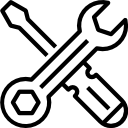HOW TO CALCULATE THE NECESSARY HEAT POWER
"Have you decided to purchase a pellet stove? Excellent choice. Pellet is a 100% natural fuel that allows you to heat your home in an eco-friendly way and at a significantly lower cost compared to fossil fuels. To choose the right model for you, you first need to understand your home's heating requirements and calculate the stove's power based on the volumes to be heated. Discover the formula for efficient heating.
How many rooms do you want to heat with the pellet stove?
Do you want to use the heat for domestic hot water as well?
If you are considering changing your home heating system and purchasing a pellet stove, you need to answer these questions first.
With a pellet stove, you can heat a single room or multiple rooms. Ducted models, in fact, allow you to channel hot air into different areas, even on different floors, heating the entire house.
With a hydro stove or thermo stove, you can generate hot water to be directed to radiators or underfloor systems, powering the heating system with the thermal energy produced by pellet combustion. You can also use the stove to heat the water for your shower and bathroom.
Once you have determined the intended use, to purchase the pellet stove model that best suits your needs, you must calculate how much heat you require. Only in this way can you know the pellet stove power that best meets your needs.
VOLUME TO BE HEATED, CALORIE REQUIREMENTS AND POWER
The heating requirement primarily depends on the volume of the space to be heated. The larger the space, the more powerful the stove needs to be.
To calculate the volume of a room, simply multiply the dimensions of the space, that is:
width x length x ceiling height
However, the choice of pellet stove power also depends on other factors, such as:
- The degree of thermal insulation of the building (low, medium, high): if the house is well insulated, you won't need a high-powered stove.
- The climate zone you live in: specifically, how cold it gets in winter and, consequently, how much heating is needed.
- The presence of lakes or watercourses near your home, which can create particular humidity conditions.
To avoid underestimating or overestimating your heating requirements, seek professional help. This way, you won't risk having to keep the stove running continuously to achieve the right level of comfort or, worse, wasting money on an oversized system that you won't fully utilize.
To get an approximate idea of the necessary thermal power, you can multiply the volume of the spaces to be heated by the thermal coefficient, which expresses the average calories needed to heat 1 cubic meter to 20-22°C.
This coefficient depends on the insulation level of the house and ranges from 30 (high insulation) to 40 (low insulation) kcal/mc.
Let's take an example.
Suppose you want to install a pellet stove to heat your 80 sqm apartment with a ceiling height of 3 meters.
If your house is newly built, has thermal insulation and insulating windows, you can choose a thermal coefficient close to 30.
80 x 3 x 30 = 7,200 kCal
After the calculation, you will need to convert the number of calories to kW. To do this, simply divide the obtained value by 862.
7,200 / 862 = 8.3 kW
The necessary pellet stove power to heat your apartment should be slightly above 8.3 kW (about 15-20% more).
8.3 kW + 15-20% = 10 kW
Here you can find an in-depth look at the best 10 kW pellet stove models.
If you live in a house from the 1990s or earlier, with poorly insulated roofs and single-glazed windows, consider a higher thermal coefficient, tending towards 40.
PELLET STOVE POWER AND EFFICIENCY
The useful thermal power of a pellet stove indicates the amount of heat the stove provides to the environment (in kW).
If you want to evaluate the efficiency of a stove, you need to consider another very important value: the efficiency rate. This value, expressed as a percentage, indicates how much of the heat generated by combustion is actually transferred to the environment.
The best pellet stoves have an efficiency rate of at least 90%, which means that out of 100 kg of pellets, 90 are effectively converted into heat. Such high efficiency rates are unattainable, for example, with an open fireplace.
Opting for pellet stove models with high efficiency is always beneficial because it allows you to save on consumption and gain access to tax deductions.


